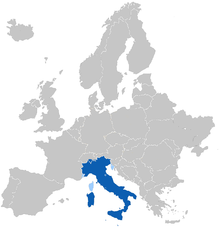
Back Аиталиа бызшәа Abkhazian Italiaans Afrikaans Italienische Sprache ALS ጣልያንኛ Amharic Idioma italiano AN Italisc sprǣc ANG इतालवी भाषा ANP اللغة الإيطالية Arabic ܠܫܢܐ ܐܝܛܠܝܐ ARC طاليانية ARY
| Italian | |
|---|---|
| italiano, lingua italiana | |
| Pronunciation | [itaˈljaːno] |
| Native to | Italy, Switzerland, San Marino, Vatican City, Slovenia (Slovenian Istria), Croatia (Istria County), and the Italian diaspora |
| Region | (widely known among older people and in commercial sectors in Somalia, Eritrea, and Libya; used in the Federal Government of Somalia) |
Native speakers | 59 million Italian proper, native and native bilingual (2007)[1] 85 million all varieties[2] |
| Latin (Italian alphabet) Italian Braille | |
| Official status | |
Official language in | |
Recognised minority language in | |
| Regulated by | not officially by Accademia della Crusca |
| Language codes | |
| ISO 639-1 | it |
| ISO 639-2 | ita |
| ISO 639-3 | ita |
| Linguasphere | 51-AAA-q |
 Where Italian is spoken in Europe | |
The Italian language is a Romance language spoken in Italy. Other countries that use Italian as their official language are San Marino, Vatican City and Switzerland. Slovenia, and Croatia also use Italian as an official language, but only in some regions. Italian is spoken by about 70 million people in several countries, including some parts of Monaco, Malta, Albania, Montenegro, Dodecanese (Greece), Eritrea, Libya, Ethiopia, Somalia, Tunisia. The standard version from Tuscany is used for most writing but other dialects are sometimes written.[3]
- ↑ Nationalencyklopedin "Världens 100 största språk 2007" The World's 100 Largest Languages in 2007
- ↑ Eurobarometer – Europeans and their languagesPDF (485 KB), February 2006
- ↑ Simone 2010